
From its earliest inceptions, science fiction has blurred the line between reality and technological fantasy in a remarkably prescient manner. Many of the discoveries and gadgets that have integrated seamlessly into modern life were first preconceived theoretically. More recently, the technologies behind ultra-realistic visual and motion capture effects are simultaneously helping scientists as research tools on a granular level in real time. The dazzling visual effects within the time-jumping space film Interstellar included creating original code for a physics-based ultra-realistic depiction of what it would be like to orbit around and through a black hole. Astrophysics researchers soon utilized the film’s code to visualize black hole surfaces and their effects on nearby objects. Virtual reality, whose initial development was largely rooted in imbuing realism into the gaming and video industries, has advanced towards multi-purpose applications in film, technology and science. The Science Channel is augmenting traditional programming with a ‘virtual experience’ to simulate the challenges and scenarios of an astronaut’s journey into space; VR-equipped GoPro cameras are documenting remote research environments to foster scientific collaboration and share knowledge; it’s even being implemented in health care for improving training, diagnosis and treatment concepts. The ability to record high-definition film of landscapes and isolated areas with drones, which will have an enormous impact on cinematography, carries with it the simultaneous capacity to aid scientists and health workers with disaster relief, wildlife conservation and remote geomapping.
The evolution of entertainment industry technology is sophisticated, computationally powerful and increasingly cross-functional. A cohort of interdisciplinary researchers at Northwestern University is adapting computing and screen resolution developed at DreamWorks Animation Studios as a vehicle for data visualization, innovation and producing more rapid and efficient results. Their efforts, detailed below, and a collective trend towards integration of visual design in interpreting complex research, portends a collaborative future between science and entertainment.
Not long into his tenure as the lead visualization engineer at Northwestern University’s Center For Advanced Molecular Imaging (CAMI), Matt McCrory noticed a striking contrast between the quality of the aesthetic and computational toolkits used in scientific research versus the entertainment industry. “When you spend enough time in the research community, with people who are doing the research and the visualization of their own data, you start to see what an immense gap there is between what Hollywood produces (in terms of visualization) and what research produces.” McCrory, a former lighting technical director at DreamWorks Animation, where he developed technical tools for the visual effects in Shark Tale, Flushed Away and Kung Fu Panda, believes that combining expertise in cutting-edge visual design with emerging tools of molecular medicine, biochemistry and pharmacology can greatly speed up the process of discovery. Initially, it was science that offered the TV and film world the rudimentary seeds of technology that would fuel creative output. But the TV and film world ran with it — so much so, that the line between science and art is less distinguishable than in any other industry. “We’re getting to a point [on the screen] where we can’t discern anymore what’s real and what’s not,” McCrory notes. “That’s how good Hollywood [technology] is getting. At the same time, you see very little progress being made in scientific visualization.”
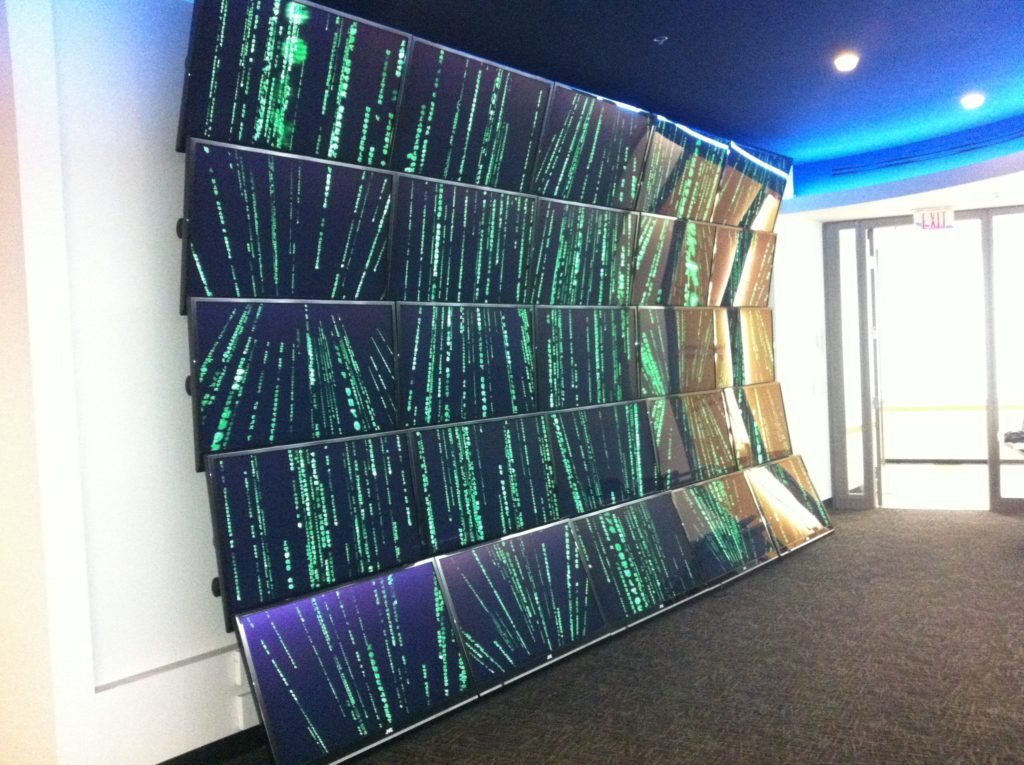
What is most perplexing about the stagnant computing power and visualization in science is that modern research across almost all fields is driven by extremely large, high-resolution data sets. A handful of select MRI imaging scanners are now equipped with magnets ranging from 9.4 to 11.75 Teslas, capable of providing cellular resolution on the micron scale (0.1 to 0.2 millimeters versus 1.5 Tesla hospital scanners, at 1 millimeter resolution) and cellular changes on the microsecond scale. The ultra high-resolution imaging provides researchers with insight into everything from cancer to neurodegenerative diseases. While most biomedical drug discovery today is engineered by robotics equipment, which screens enormous libraries of chemical compounds for activity potential around the clock in a “high-throughput” fashion — from thousands to hundreds of thousands of samples — data must still be analyzed, optimized and implemented by researchers. Astronomical observations (from black holes to galaxies colliding to detailed high-power telescope observations in the billions of pixels) produce some of the largest data sets in all of science. Molecular biology and genetics, which in the genomics era has unveiled great potential for DNA-based sub-cellular therapeutics, has also produced petrabytes of data sets that are a quandary for most researchers to store, let alone visualize.
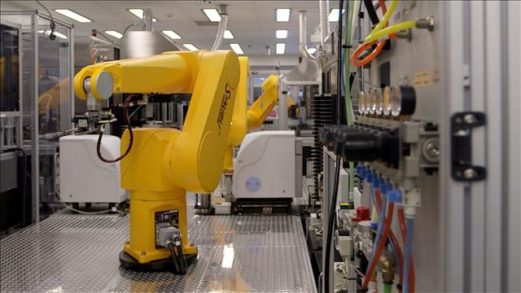
Unfortunately, most scientists can’t allocate dual resources to both advancing their own research and finding the best technology with which to optimize it. As McCrory points out: “In a field like chemistry or biology, you don’t have people who are working day and night with the next greatest way of rendering photo-realistic images. They’re focused on something related to protein structures or whatever their research is.”

The entertainment industry, on the other hand, has a singular focus on developing and continuously perfecting these tools, as necessitated by proliferation of divergent content sources, screen resolution and powerful capture devices. As an industry insider, McCrory appreciates the competitive evolution, driven by an urgency that science doesn’t often have to grapple with. “They’ve had to solve some serious problems out there and they also have to deal with issues involving timelines, since it’s a profit-driven industry,” he notes. “So they have to come up with [computing] solutions that are purely about efficiency.” Disney’s 2014 animated science film Big Hero 6 was rendered with cutting-edge visualization tools, including a 55,000-core computer and custom proprietary lighting software called Hyperion. Indeed, render farms at LucasFilm and Pixar consist of core data centers and state-of-the-art supercomputing resources that could be independent enterprise server banks.
At Northwestern’s CAMI, this aggregate toolkit is leveraged by scientists and visual engineers as an integrated collaborative research asset. In conjunction with a senior animation specialist and long-time video game developer, McCrory helped to construct an interactive 3D visualization wall consisting of 25 high-resolution screens that comprise 52 million total pixels. Compared to a standard computer (at 1-2 million pixels), the wall allows researchers to visualize and manage entire data sets acquired with higher-quality instruments. Researchers can gain different perspectives on their data in native resolution, often standing in front of it in large groups, and analyze complex structures (such as proteins and DNA) in 3D. The interface facilitates real-time innovation and stunning clarity for complex multi-disciplinary experiments. Biochemists, for example, can partner with neuroscientists to visualize brain activity in a mouse as they perfect drug design for an Alzheimer’s enzyme inhibitor. Additionally, 7 thousand in-house high performing core servers (comparable to most studios) provide undisrupted big data acquisition, storage and mining.
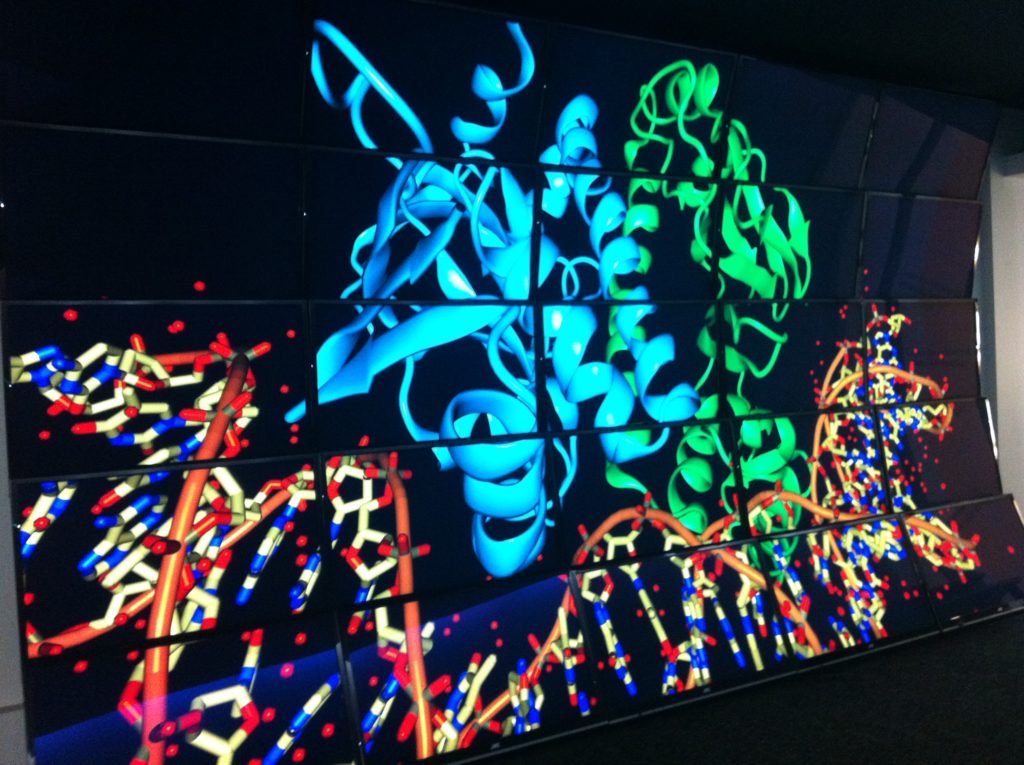
Could there be a day where partnerships between science and entertainment are commonplace? Virtual reality studios such as Wevr, producing cutting-edge content and wearable technology, could become a go-to virtual modeling destination for physicists and structural chemists. Programs like RenderMan, a photo-realistic 3D software developed by Pixar Animation Studios for image synthesis, could enable greater clarity on biological processes and therapeutics targets. Leading global animation studios could be a source of both render farm technology and talent for science centers to increase proficiency in data analysis. One day, as its own visualization capacity grows, McCrory, now pushing pixels at animation studio Rainmaker Entertainment, posits that NUViz/CAMI could even be a mini-studio within Chicago for aspiring filmmakers.
The entertainment industry has always been at the forefront of inspiring us to “dream big” about what is scientifically possible. But now, it can play an active role in making these possibilities a reality.
*****************
ScriptPhD.com covers science and technology in entertainment, media and advertising. Hire our consulting company for creative content development. Follow us on Twitter and Facebook. Subscribe to our podcast on SoundCloud or iTunes.

You can always tell you’ve gone too far when you reach the wind farms. They populate the barren wastes of California’s northern interior, rows of them spinning atop camel-haired hills starved of moisture to slake the thirst of the Los Angeles glitterati. These motionless pinwheels are an ironic green afterthought to the ecological disaster that embraces the Interstate-5 freeway: now that we’ve created the dust bowl we may as well use the wind to power our air filters. There’s more than wind and dust out here. This is where they put the kinds of facilities the government doesn’t want people snooping around in. Lawrence Livermore National Laboratory is one of them—a secretive development center for our nation’s nuclear arsenal during the Cold War. Here in Livermore, the world’s finest physicists are on the verge of a breakthrough that could power entire cities on a bathtub full of water. The National Ignition Facility, also known as the world’s largest laser, is on the cusp of achieving the first break-even nuclear fusion reaction. NIF is the U.S. Department of Energy’s Sagrada Familia. If successful, the four billion dollar facility will be the first ever to demonstrate Ignition: a fusion reaction that releases more energy than was put into it. The energy, national security, economic and environmental ramifications for the United States, if not the world, would be staggering. ScriptPhD.com’s Stephen Compson gained ultra-exclusive access to the normally reclusive facility, including tours, interviews, and a peek at the lasers that could hold the key to the United States’s global rebirth. With nuclear fusion on the brink of break-even, Stephen recounts we tour the world’s next scientific revolution.
The Photon Valley
Livermore is not so much a city as it is a byproduct of the lab at its center. This small suburban community lies halfway between San Francisco’s Bay Area and the Interstate 5 that allows truckers a north-south passage between the “Two Californias.” They call it The Photon Valley, the world capital of laser technology and all things light-related. Moth-like high-tech subcontractors orbit the facility’s perimeter. Charon Sue Wollard is Livermore’s second Poet Laureate. Her poem Steller Gest hints at the secrets locked away in the cathedral of optics:
amid the shadows of the Earth
while a future barely glimpsed
is in a chamber being birthed”
I check into a room that smells like a Pine-Sol explosion and cruise the two main drags looking for a meal. A pretty girl takes my order at a pizza place, and I realize for the first time what a physics town this truly is. Her eye shadow has been cross-sectioned into bandwidths, showing five different colors on each eyelid. It is a cosmetic display of the visible light spectrum. She smiles and asks if I’d like a beer.
Fusion is the process by which two atomic bodies, driven together by an overwhelming force, merge to become one heavier nucleus. It is the reverse of fission, the splitting process that gave us the atomic bomb and the conventional nuclear reactor. An atomic act of coupling, fusion powers our sun and every other light in the night sky. At the National Ignition Facility here in Livermore, scientists and engineers stand at the threshold of tapping into that process to create a limitless supply of clean energy. When the stars burn out, we’ll make our own.

The Birth of a Star
The car is completely covered in bird crap. This isn’t just one or two droppings caked onto a dirty hood, but a carpet-bombing by a flock of irritably-boweled miscreants. Lynda, the public affairs officer assigned to chaperoning me through the facility, smiles apologetically and gestures toward the culprits in the dense trees that loom over the parking lot.
Like a quiet family home in mid-Los Angeles, the Livermore Lab hides from prying eyes with a protective wall of foliage that makes it look more like a nature preserve than a nuclear weapons facility. But behind the trees they have plenty of barbed wire and guards armed with assault rifles. I finger the clearance pass with my photo on it and thank her for the souvenir. She looks puzzled, “You won’t be allowed to keep it.” Bruno Von Wonterghem is exactly the sort of Germanic super-scientist you’d imagine running operations at the world’s largest laser facility. His accent lends an easy everyday quality to words like laser, optics, and Neodymium. He has the propensity to trail off into a mumble that could fill an entire page, like he’s been talking about the laser’s attributes merely for his own benefit. Bruno has been working on laser systems at the lab for almost two decades. Every time I ask a question this strange light comes into his eyes, as though he’s realizing for the first time that there are people in this world who don’t know about the National Ignition Facility.

From the outside, the building doesn’t quite look real. It’s glossy, like one of those photos a developer might put up in front of a vacant lot to convince people that something could be built there. I’ve been trying to get into this facility for over a year, and to my disappointment it looks exactly like the pictures. Most of the facility’s iconic equipment is on display in the front lobby, and the walls throughout are lined with posters explaining how everything works. The whole thing screams field trip, and I’m starting to wonder if there is actually any science that takes place here. Then they show me the laser bays.

Every article you will ever read about the National Ignition Facility measures the size of its laser bays in terms of football fields (four). It’s difficult to get a feel for the scale from the picture, because this is only one of two laser bays and what you don’t realize looking down on it is that the whole system is suspended a story above the ground, putting us three stories up. They do that because any replacement modules have to be loaded from underneath in pre-assembled clean rooms so that any outside particles will fall out of the system.

After giving me a minute to ogle, Bruno clears his throat. “The Facility is essentially an energy concentrator in time and space. It takes about sixty seconds to charge up the capacitor bank with six megawatts, but the laser releases that energy in a very short amount of time: billionths of a second. Those six megawatts are concentrated by over fifteen orders of magnitude, more power than the entire United States electrical grid.” The cool thing about lasers is that they have an unlimited threshold for delivering power. Photons, the packets that physicists use to quantify light, occupy no space, so you can pack an unlimited number of them into as focused a path as your lenses allow.
The charge process concentrate the lasers through time, and the lenses concentrate them through space. Each of the tubes acts like a telescope, converging NIF’s 192 beams onto a single capsule the size of a vitamin, gaining another nine orders of magnitude in the process to create temperatures hotter than the inside of the sun.

At the molecular level, heat causes vibration. The hydrogen ions in the fuel capsule are both positively charged, so they magnetically repel one another. However, the supercharged laser creates a perfectly symmetrical layer of plasma around the target. There’s nowhere for the ions to run, and as they heat up and accelerate to over a million miles per hour, the two cores inevitably fuse to become a hydrogen atom, releasing some of their mass as energy in the form of neutrons. Each laser bay contains 96 beams, one in each steel tube. Thick black high-voltage cables snake along the outside delivering power to the amplifiers. The tubes are filled with Argon gas because air reacts with lasers and impedes their progress. Aside from the amplifiers, the lasers also pass through pink slabs of neodymium that add juice to the discharge. The shot bounces through the entire array four times before it enters the switchyard into the target bay.
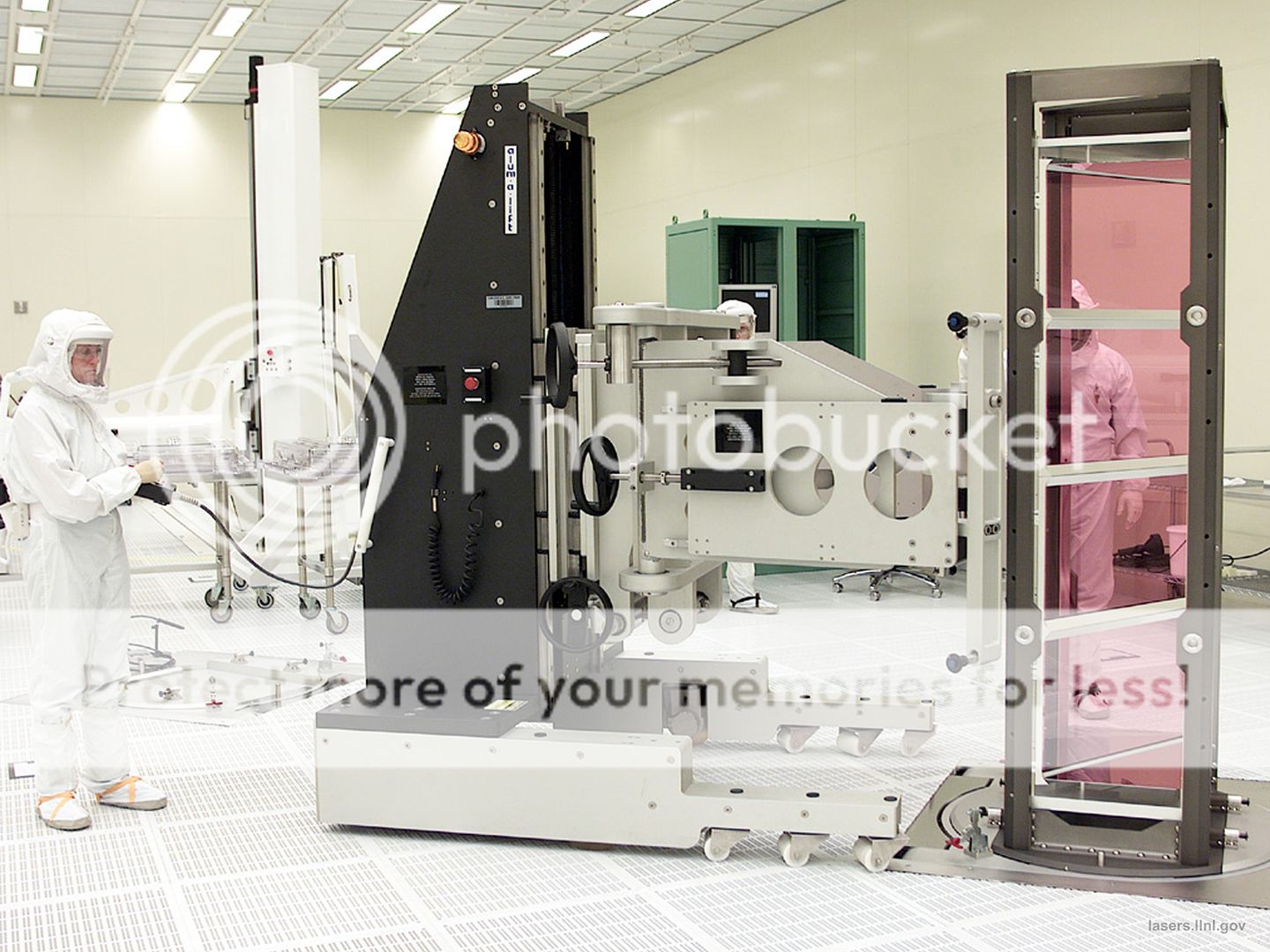
This is the world’s largest optical system. There are over 70,000 large optical controllers and 30,000 smaller optics. As we look over it all from the third floor, Bruno sniffs, “If you could look through all these tubes and strip away all this steel, you would find a sea of optical elements. It would be beautiful. Right now, it just looks like tubes.”
Between the Conception and the Creation

Every shot starts in the Oscillator Room, which is a somewhat disappointing set of server-like cabinets containing the three oscillators that send out the initial pulse to the preamplifiers. This starting pulse is only a billionth of a joule, or 1/160th the kinetic energy of a flying mosquito. A fairly humble beginning for a star’s birth. They use the three oscillators in tandem to fine-tune the timing of the pulse down to a few trillionths of a second. The oscillators run constantly, but only one of these pulses will enter the amplifiers to begin powering up for a shot. A large red counter keeps track of all pulses that pass without notice through the fiber-optics, unable to reach their full potential in the adjacent laser bays.
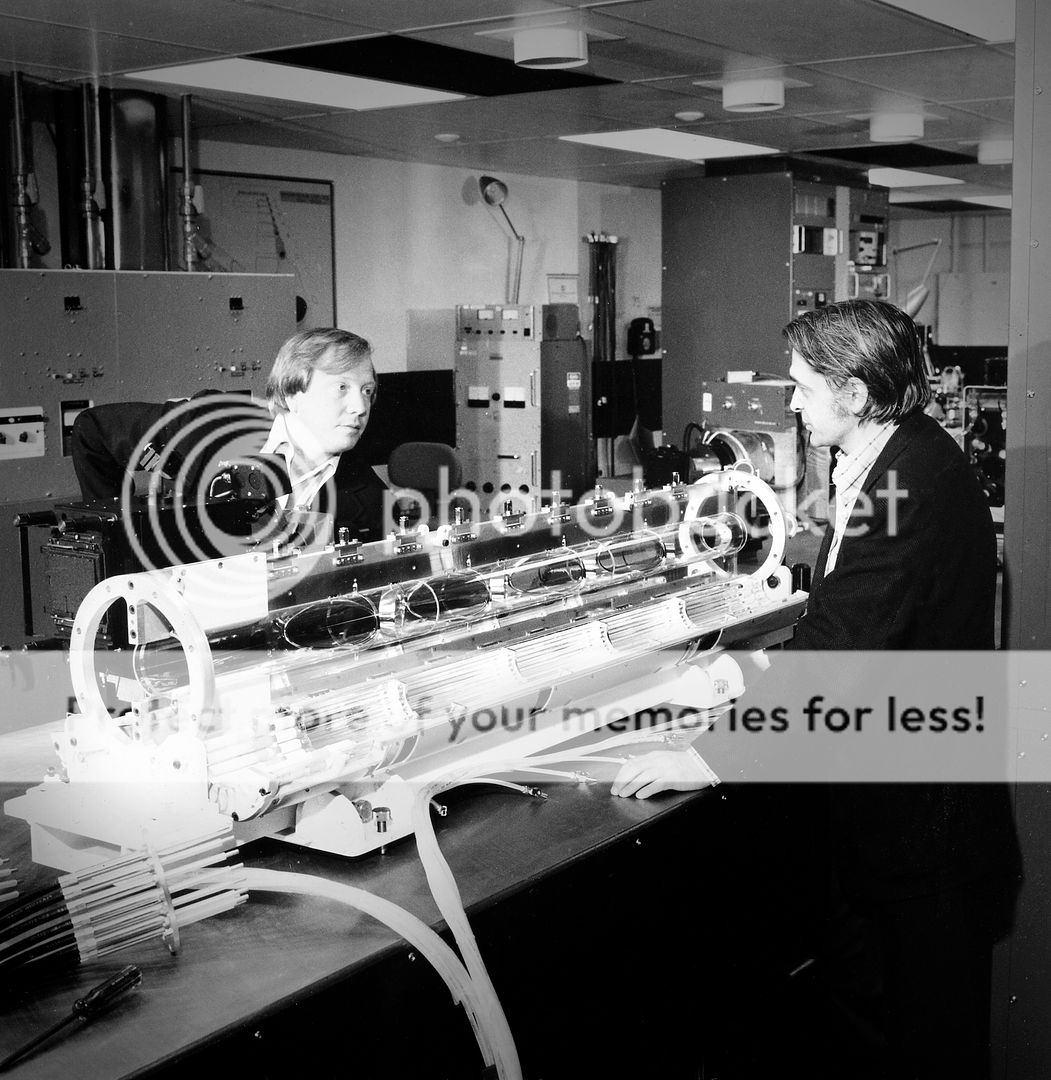
In 1957, John Nuckolls began investigating peaceful applications of nuclear weapons technology. He proposed a novel scheme: the implosion of a Deuterium-Tritium (hydrogen isotopes) fuel capsule inside a tiny holhraum driven by an external energy source (refer to above graphic). This is the same scheme NIF uses today, but at the time when Nuckolls proposed it the laser had not yet been invented, so he considered other exotic power sources like particle accelerators, plasma guns, and hypervelocity pellet guns, which sound suspiciously like glorified BB guns.
The reaction that takes place at NIF today is almost identical to the one Nuckolls designed in the 60s, but the physicists needed a laser system capable of generating a pulse hotter than the core of our sun to achieve ignition. First they built the SHIVA laser, named for Oppenheimer’s proclamation that he had become the destroyer of worlds after unveiling the atomic bomb. SHIVA was followed by NOVA, NIF’s predecessor and the first laser system Bruno worked on at the facility. In late 2009, almost fifty years after the idea was conceived, NIF successfully demonstrated the temperatures necessary for energy gain ignition. “It was so much bigger than any of us ever imagined,” Bruno reflected. “When we bring in the original scientists to look at the target bay, they sort of look around in awe and say, ‘We can’t believe this is what we asked for.’”


The target chamber is a 10-meter diameter aluminum sphere with laser tubes sprouting from its surface. From the outside, it looks like one of those alien objects from Contact or Sphere. It spans three stories of the facility, so you can only ever look at it from above or below. We stand on the third floor watching a crew of workers install some newly hardened diagnostic equipment. They’ve spent the past six months preparing the target chamber to absorb the massive amount of energy released by the fusion reaction. The entire chamber is now surrounded by a concrete and boron barrier two meters thick. In the LIFE facility, a commercial power plant designed to actually generate electricity, the neutrons will be absorbed by a mantle of liquid salts that transfer their kinetic energy to heat energy which drives a conventional steam generator. However, because NIF is an experimental facility where they actually need to observe the reaction, its physicists were presented with the challenge of preparing cameras that could withstand the bombardment, since neutrons lay waste to electronics.
The density of the imploding target is so high that normal x-rays can’t penetrate the implosion’s surface, so they concentrate four x-ray beams to over a Petawatt, which is a quadrillion watts (yeah, real number). The reaction itself is only a tenth of the size of a human hair, and it boggles even the scientists who work there that they have an x-ray powerful enough to observe it. They call this camera Dante, “because it looks into the mouth of hell.” Despite the incredibly powerful forces at work, Inertial Confined Fusion is safer than any of the power-generating technologies that have preceded it. The key thing to remember is that the reaction is an implosion, not an explosion. If anything goes wrong, the whole thing collapses on itself and nothing happens. The worst thing that can happen is all the fuel gets consumed and we’re out one more capsule. There’s no possibility of a catastrophic meltdown like Three Mile Island or Chernobyl. Lynda deals with this line of questioning all the time: “People hear that NIF generates temperatures hotter than the sun and that it creates a miniature star and they wonder how the whole facility doesn’t melt down. But we’re talking about an implosion, with an incredibly small scale, for only a few billionths of a second. It’s no different than a supernova, the physics are all the same, but the scale’s a bit smaller.”

Holhraum is the German word for “hollow room.” It has been mostly analogized to a pill capsule, in reference to its size and shape. Its role is to act as an x-ray oven, containing the plasma generated around the target pellet and acting as a mold for the fusion reaction’s symmetry. The holhraum contains the fuel pellet made up of the hydrogen isotopes Tritium and Deuterium. There’s no danger of scarcity with these two elements: Tritium is derived from the relatively common Lithium and Deuterium comes from plain old water. Another advantage to fusion is that there’s no waste created, at all. Everything is consumed by the reaction, leaving behind no toxic radiation or weaponizable elements. In fact, physicists can use facilities like NIF to dispose of the nuclear waste from the previous generation of fission reactors, rendering the arguments about Yucca mountain or blasting it into space completely moot.

The shot director begins the countdown, and alarms sound throughout the facility. Daylight hours at the facility mostly consist of construction and maintenance work, they fire the lasers at night. There are only twenty people in the facility during a shot, and they’re all here in the control room, but they have the alarms just in case. The countdown is four minutes, which seems like an incredibly long time. Nearly all of the process is controlled by computers, a necessity for the minute level of control required to achieve symmetry. The control room looks a lot like NASA’s Mission Control. They like to hire nuclear submarine captains as shot directors, because of the rigidity in operations requirements. “We can train them with the technical knowledge, but having that operations experience from a submarine where things are going on all around you is essential. There’s a lot of action during a shot, but each one can take up to twelve hours. It’s like loading a new missile every day.”
As we reach the final few seconds of the countdown, I look around nervously. The overhead lights flash, and that’s it. No sound effects, no shaking. I have to ask if it worked. The only noise comes from the physicists next door scrambling to be the first to retrieve the data. Lynda leans over, “When you take the amount of shots fired in an entire year, where each one only takes a fraction of a second, it’s almost like this thing is never really on.”
Countdown to Ignition
The National Ignition Campaign coincides with football season, but the stakes are a little higher. Ignition is the validation of fusion as a viable energy source, the point at which the critics are silenced and the rest of the world scrambles to duplicate the feat. “It’s going to be incredible, standing room only. There’s people lining up around the world that want to be here for that event. Every milestone along the way has been a major event, when we went from two to four lasers it was a major event. Now we have 192. And it’s all leading up to the ignition.” The question they must get tired of hearing is: when? “September, October. There’s a few [target] options we have, a plastic capsule, a beryllium capsule, a diamond capsule.” I ask Bruno which one he thinks will do the trick. It’s important not to underestimate the technological perfection required to achieve the symmetry necessary for the ignition. Every aspect of the shot must be analyzed and optimized to an order of precision never before achieved. With all that said, he doesn’t see any reason why the plastic capsule won’t get the job done.
I have to press: “The plastic capsule, that’s going to be the one?” Bruno replies with a tremor in his voice. Like the girl who’s fallen for too many bad boys, he’s been hurt before, “I believe that will be the one, yes.”
Are you ready for some Physics?
The above title sounds a lot more enticing if you sing it to the Monday Night Football theme song. There’s no good reason why I should be allowed into a nuclear weapons lab. I’m nobody, another starving bookworm with a taste for Faulkner and single barrel scotch. All I can surmise is that so far, no-one’s managed to pull this four billion dollar sword from its stone and shove it somewhere that will make the American public pay attention. I’m living proof that they’re desperate. No one I know has even heard of the National Ignition Facility, which quite sadly included the Editor of ScriptPhD.com who sent me there. I’ve spoken with professional engineers and physicists who don’t recognize the name. There’s certainly been plenty of media coverage: the BBC, the Discovery Channel, Wired, Time. People’s ears tend to perk up when they hear something might kill them, but the general public hasn’t had a survival-based reason to pay attention to physics since the end of the Cold War. We know that unruly nations getting access to nuclear weapons is a bad thing, but as to the current state of the field, a nuclear warhead is implicitly bad enough that there’s been no reason to continue following their progress.
Fusion offers us the solution to a problem most people don’t even know we have. The immediacy of it isn’t so clear, but in his excellent BBC Horizons: Can We Make a Star?, Professor Brian Cox paints a grim picture. It’s not possible to give the rest of the world access to even half the electricity that the average American uses without bankrupting all possible means of generating electricity, and in the process laying waste to the environment.
We have to figure out how to generate electricity for the growing population around the world without, as Bruno likes to say, choking ourselves. The actual numbers are sobering, but it’s a subject people don’t like to read about because in the past there’s been no clear solution. Now here we are, being handed that solution on a silver platter by a group of individuals that no one’s heard of who have been working on that solution for the last fifty years. Which only makes the endeavor that much more noble.
The Holy Grail
When I began this trip, I had no idea that I would be making a pilgrimage. Bruno and his co-workers are like stonemasons laying the foundation for a church they will never live to see. It will be at least twenty years before the first commercial fusion reactors come online (skeptics put the time-frame around 2050). John Nuckolls, the man who came up with Inertial Confinement Fusion, is in his nineties. Five thousand people have spent their lives building this facility up to this point. They are the clergy of the modern era, humanity’s most educated class, working selflessly to create a better world. “People want to be here to work on a mission. The goal is really very abstract to many of them, but they’re all motivated by being able to contribute to an event where they can make history. There’s a grand challenge to it, a vast significance in being a part of that.”
Gone are the days when the average American held down a job for the same company his or her entire working life, but many at the National Ignition Facility join the team when they finish their doctorates from the world’s finest universities and work there until they retire. There are fathers who have spent their entire careers working on fusion only to see their son or daughter take up the cause. Remarked Bruno: “We have to think long term. You need technology that can carry you beyond fifty and a hundred years into the future. When you think about your great grandchildren, this is the only solution, the only way that we can survive with the quality of life that we’ve become accustomed to. It is our holy grail.”
The Neutron Age
The achievement of energy gain fusion is one that should fundamentally alter human existence. As technology advances, our quality of life will remain intimately connected with access to cheap, renewable energy. There are existential stakes as well. Fusion is the engine that drives our universe. By achieving Ignition, we begin our mastery of Mother Nature’s own energy source, a force so fundamental that cultures around the world worshiped its daily appearance at dawn. “Every fifty to a hundred years you reach a point where you make a quantum jump in technology. We went from coal in the industrial age to the atomic age in the fifties and now we will reach the neutron age. We can finally see an opening into the energy problem. Within fifty years you could provide a significant fraction of your basic power production from fusion. You can give this to developing countries and bring them into a new century. Suddenly someone with no refrigerator, no microwave will realize what it means to live in the modern age. We have a quality of life here in America that simply cannot be provided around the world with the resources we have. Fusion will make that possible.”
Clean power is only the beginning. Like the technologies that emerged from the Pandora’s box of quantum mechanics, fusion will undoubtedly open up a whole new wave of technological advancement. Every aspect of the National Ignition Facility, from the optics that carry the lasers to the supercomputers that process the data have pushed the limits in their field. Bruno gives me a sly look. “We probably have no idea yet what applications will come from having a neutron source like this.” And thanks to the NIF’s tireless believers, we enter that neutron age this fall.
Stephen Compson studied English and Physics at Pomona College. He writes fiction and screenplays and is currently working toward a Master of Fine Arts at UCLA’s School of Theater, Film & Television.
~*Stephen Compson*~
************************
ScriptPhD.com covers science and technology in entertainment, media and advertising. Hire our consulting company for creative content development.
Subscribe to free email notifications of new posts on our home page.
]]>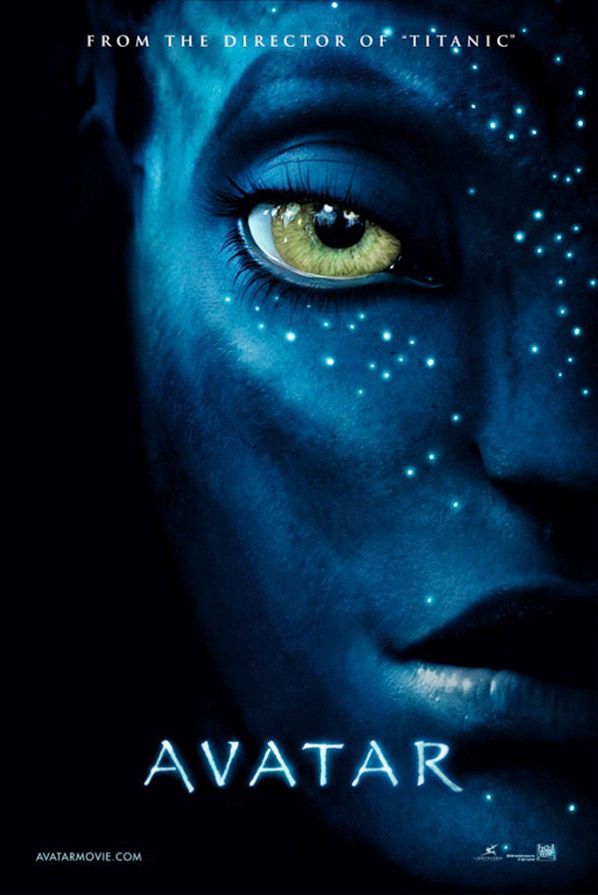
There are certain films that outlive their theatrical releases to become evolutionary stepping stones of filmmaking. Long after the popcorn has been munched and the Oscars handed out, these movies stand the test of time and usher in the cinematic equivalents of geologic Eras. D.W. Griffith’s The Birth of a Nation redefined the beauty of silent imagery. Alan Crosland’s The Jazz Singer integrated sound and heralded the rise of “the talkie.” Orson Welles’s Citizen Kane became a hallmark of big-budget studio genius. And every sci-fi film of the last forty years owes debt to the standard set by Stanley Kubrick’s 2001: A Space Odyssey. And then there is Avatar. That this film, with fifteen years of creative development, four years of full-time work, and endless hype, was bound to be good seems like manifest destiny. But it doesn’t just live up to its hype—it exceeds it. James Cameron has reinvented visual possibilities, perfected multi-layered storytelling and provided a service to audiences and filmmakers. He has transitioned us into the next big cinematic Era: 3D. Avatar is a ScriptPhD.com Editor’s Selection. For a full review, please click “continue reading”.
REVIEW: Avatar
ScriptPhD.com Grade: A+ (Editor’s Selection)
The year is 2154. The Earth has long been pillaged of its resources and habitability. Looking to solve this impending energy crisis, a human colony has been mining for the valuable mineral ‘unobtanium’ for three decades on Pandora, a distant Moon of the Alpha Centauri-A star system. At 4.4 billion light years away, travel to Pandora requires six years of arduous travel in cryogenic hibernation. Although possessing an Earth-like environment, Pandora’s atmosphere is toxic. Furthermore, native denizens, a humanoid Na’avi tribe, present a direct threat to humans, due both to their advanced biomechanical structure and animosity towards their occupiers’ fixations on what they feel is their sacred native land. In order to explore the territory safely, human being “drivers” must virtually connect their consciousness to a physical avatar hybrid composed of 50% human DNA and 50% Na’avi DNA. Referred to pejoratively by the Na’avi as “the sky people,” human imperialists become increasingly aggressive about destroying native territory to harvest ‘unobtainium,’ leading to perilous tensions between the two groups and the brink of all-out war.

Enter Jake Sully (Sam Worthington), an accidental everyman hero and paraplegic ex-Marine. No doubt an ode to Cameron’s own brother John David, who served in the first Gulf War and even helped train Worthington for the role, Sully is lacking in mobility but still a warrior at heart. After the death of his twin brother, a scientist at the Avatar Program, Sully is the only one whose DNA matches and can drive his brother’s Na’avi avatar. Overly eager to use his new virtual body, Jake gets trapped on Pandora and saved by the beautiful Princess Neytari (Zoë Saldana). Far from viewing him favorably, she can’t ignore an auspicious sign from the Na’avi deity Eywah that Jake must become one of them and learn their ways. This is music to the ears of chain-smoking tough-as-nails head scientist Dr. Grace Augustine (Sigourney Weaver, flawless), who sees this as an opportunity to study the Na’avi in an unprecedented way. Colonel Miles Quatrich, a despotic Rambo played with jingoistic abandon by Stephen Lang, recruits Sully as special ops to learn the Na’avi weaknesses and where they may be infiltrated. Mediating the two camps is Resources Development Administration agent Parker Selfridge (Giovanni Ribisi), an insipid corporate monger who will work with whichever side leads to the ‘unobtainium.’ The scientists’ interests are purely the biology of Pandora and forging diplomacy with its peoples, the military to wield might (shock and awe, anyone?), and the RDA to make as much money as possible. Jake is caught between arbitrating these opposing human interests as he connects spiritually with the natural beauty of Pandora and falls in love with Neytiri. He must choose which side he will fight for and where his loyalties lie.
We have already written extensively earlier this week about the scientific and technological breakthroughs in the making of Avatar in our post entitled Behind Avatar: Science, Technology, Art and Design. This review is primarily concerned with its artistic achievements, which are significant. While some of Cameron’s derivative dialogue is a consistent weakness in his screenplays, he makes up for it with rich characters and familiar archetypes, particularly his trademark strong woman (in this case fulfilled dually by Weaver’s Augustine and Saldana’s Neytiri). Augustine is the kind of knowledgeable, authoritative female scientist we wish would get portrayed in mainstream film, and is equal parts firm with the inexperienced non-scientist as she is empathetic with his journey to Na’avi manhood. Neytiri is an exceptionally complex female lead, and a big credit to Saldana for a nuanced performance filmed in a virtually empty box. Neytiri teaches Jake to hunt, survive, and roam the treacherous land with a strong hand, but opens his eyes to where the true sacred wealth of her world lies—in respect for the Earth, the animals, the spirit and the biology, not what lies in the ground. Rounding out the cast are terrific CCH Pounder as Moat, Neytiri’s mother and Na’avi matriarch, Michelle Rodriguez as the rogue helicopter pilot Trudy Chacon (whose conscience leads to a very important role towards the end of the film), and Joel David Moore as über-nerdy scientist Norm Spellman, Jake’s Na’avi language coach.
The highlight of Avatar, and the price of admission, is the surreal beauty of the viewing experience and CGI melded seamlessly with live-action sequences shot in stereoscopic 3D. Cameron’s genius directing avoids the over-the-top action of Terminator or melodrama of Titanic to let the surroundings play a key role, if not the major role, in the film. He went to great lengths to create a unique flora and fauna for Pandora and he lets them shine. Nighttime scenes shot in bioluminescent forests, each footstep lighting a path on mystical trees, collapsing flowers, fluorescent foliage, fruit of impossibly vivid color, are nothing short of magical. Certain panoramic shots or flying sequences transported The ScriptPhD to childlike wonder, slack-jawed and only capable of a primitive ooooooh or ahhhhhhhh. Animals, eliciting enormous respect in the Na’avi culture, are at the epicenter of this film. The entire ark of Cameron’s creations, ranging from the most powerful Tyrannosaurus-like behemoth to the most delicate winged creature, is designed with precision and detail. By far the most critical of these is the banshee, a dragon-horse-eagle hybrid that must be tamed individually by each Na’avi before being adopted as a flying vehicle. Technical prowess in the penultimate human-Na’avi and banshee-military vehicle battle sequences are near perfection and can easily vie with the most beloved war movies of all time. So put on your 3D glasses, sit back, and prepare yourselves to be transported to an unimaginable universe.

Avatar is a modern film that smartly tackles many of the moral and academic quandaries we struggle with as a 21st Century society, including the environment, resource management, conflict, global imperialism and corporate greed. It sets new technology standards in digital animation and CGI. But it’s also a pure love story, an old-fashioned sci-fi thriller, an adventure and a centuries-old fable about acceptance, alienation and connection. “I wanted to create a familiar type of adventure in an unfamiliar environment by setting the classic tale of a newcomer to a foreign land and culture on an alien planet,” Cameron said. “The story is by design classic in its broad strokes, but we have plenty of twists and turns in store for the audience. I’ve dreamed of creating a film like this, set on another world of great danger and beauty, since I was a kid reading pulp science fiction and comic books by the truckload, and sitting in math class drawing creatures and aliens behind my propped up
textbook.” We are all grateful beneficiaries of the realization of his dream.
Avatar Trailer:
Avatar goes into wide release in IMAX and theaters nationwide on December 15, 2009.
~*ScriptPhD*~
*****************
ScriptPhD.com covers science and technology in entertainment, media and advertising. Hire our consulting company for creative content development.
Subscribe to free email notifications of new posts on our home page.
]]>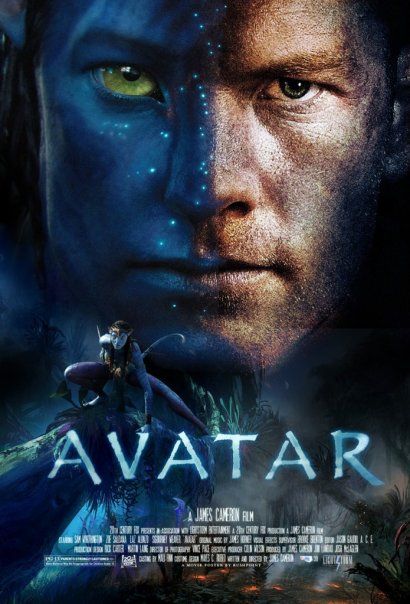
This weekend, millions of people will flock to IMAX theaters and cinemas around the world, 3-D glasses eagerly perched, in anticipation of James Cameron’s masterpiece Avatar, a cinematic œuvre fifteen years in the making. Underscoring this two and a half our epic lie unparalleled technological, scientific and artistic achievements, including the invention of a novel 3-D film camera, the complete biological and linguistic realization of a virtual world, and flawlessly integrated art direction and conceptual renderings. Many people’s post-viewing reaction will be, “How did they do that?!” ScriptPhD.com is proud to present a special Avatar preview that includes behind-the-scenes secrets and a review of the must-own companion design book The Art of Avatar. Before you see the movie, get to know it.
Fresh off of astronomical success with Titanic—11 Oscars and the highest-grossing revenue of all time—James Cameron could have done anything. He was King of the World, remember? Any film, any project, the sky was the limit. Instead, he disappeared, only to reemerge in 2005 to propose a new big-budget blockbuster to 20th Century Fox. They funded a $10 million 5-minute prototype for Avatar, but hesitated green-lighting full production, citing the 153-page script (first conceived in 1995), ambitious new video technology, and a story producers feared would alienate audiences. Only when Disney expressed interest in the film did they give Cameron a full go-ahead. The result is a movie with a final budget of over $230 million that required four years’ of full-time work to complete. Avatar is a sweeping epic that takes place on fictitious Pandora, a distant moon in the Alpha Centauri-A star system that has been colonized by humans in the year 2154. Discovery of an abundant precious ore, unobtanium, that might solve Earth’s energy crisis leads corporate and military interests to infiltrate the ranks of a native population of humanoids called the Na’avi. Because of a toxic atmosphere, human “drivers” link their consciousness to genetically engineered avatar models—50% human DNA, 50% Na’avi DNA. Jake Sully, a paraplegic ex-Marine, has been called to take his dead brother’s place for scientific exploration of Pandora’s ecosystem, biosphere and indigenous peoples. Inadvertently enveloped into learning the Na’avi culture and ways, Jake soon falls in love with the Princess Neytari and becomes caught in a battle between his own people and the virtual world he has adopted. Avatar, however, transcends whatever story or theme one imagines to define it. It is a pinnacle of scientific and technological innovation, an ode to its filmmaker’s vast travels (earthly and underwater) and intergalactic fascinations, and a harbinger of a filmmaking style that will redefine 21st Century cinema. “This film integrates my life’s achievements,” Cameron said in a New Yorker profile earlier this fall. “It’s the most complicated stuff anyone’s ever done.”
The Technology
•Performance Capture
Motion capture and computer-generated imagery (CGI) are not new to film. Motion capture (or green screen technology) was first introduced by Cameron for Total Recall, with the first CGI human movements added later for Terminator 2. It is, however, inherently limiting to the size and proportions of the human body, in particular the actor of the character being portrayed. The eyes can’t be moved, for example, and makeup often inhibits actor performance. CGI is traditionally done by placing reflective markers all over an actor’s face and body, which are then interpreted by computer technology to create digitized expressions for the CG character. However, the gulf between human and CG expression, referred to as the “uncanny valley”, is often quite noticeable. To bridge the two and create the first truly seamless hybridized CGI, Cameron and his team developed a new “image-based facial performance capture”, requiring the actors to wear special headgear rig equipped with a camera. With cameras placed just inches from their face, actors’ every muscle contraction or pupil dilation was captured and digitized, creating astounding emotional authenticity to their Na’avi avatar counterparts. “If Madonna can be bouncing around with a microphone in her face and give a great performance,” Producer Jon Landau said in a New York Times interview, “we thought, ‘Let’s replace that microphone with a video camera.’ That video camera stays with the actor while we’re capturing the performance, and while we don’t use that image itself, we give it to the visual-effects company and they render it in a frame-by frame, almost pore-by-pore level.” The scope of clarity and precision of the head-rig allowed for a much larger capture environment than ever before, a bare stage called the “Volume”, six times larger than any previous capture environment.
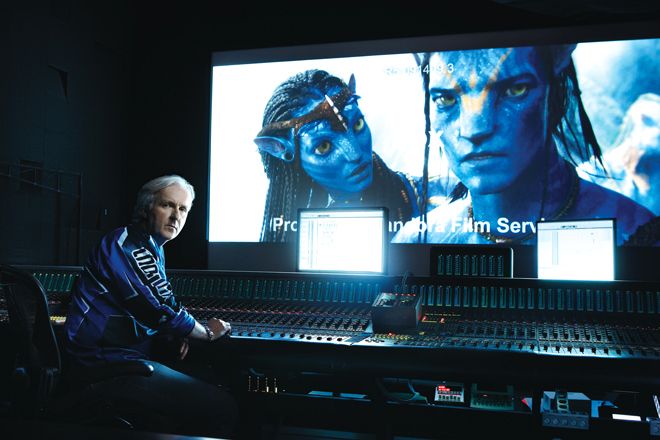
•Digital animation
State-of-the-art animation renderings for Avatar were done by Peter Jackson’s New Zealand-based digital-effects studio Weta Digital. A team of talented artists transferred basic renderings (more on this below) into photo-real images, particularly using new breakthroughs in lighting, shading, and rendering. “I’ve seen people looking at Avatar shots, being convinced they are somehow looking at actors in makeup,” Jackson says. The realism was extended to each leaf, tree, plant and rock, which were rendered in WETA computers. Additionally, a team of artists, headed by Academy Award winner Richard Taylor, designed the props and weapons for the Na’avi and humans. All of this digital design took over one year to complete and took up over a petabyte, one thousand terabytes, of hard drive space!

•Stereoscopic 3D Fusion Camera System
As far back as ten years ago, James Cameron had wanted to develop a 3D camera. At that time, the concerted goal was to use it to shoot a gritty Mars movie that would act as an emblem for space exploration (Cameron is on the advisory board of NASA). At this time, stereoscopic 3D cameras were the size of washing machines and weighed 450 pounds. The challenge issued to production partner Vince Pace was to develop a lightweight, quiet camera capable of shooting in both 2D and 3D. The result of over seven years of hard work was the groundbreaking new Fusion Camera System, the world’s most advanced 3D camera. It facilitated an almost flawless merger between live action scenes and CG scenes. Most of the live-action scenes were shot in Wellington, New Zealand on sets constructed by a massive team of 150 contractors. Live-action sets included the link rooms (where the humans transported to their Na’avi avatars, the Bio-Lab, the Ops Center military operations area, and the Armor Bay military stronghold, which housed all the weapons and transport units.
•Virtual Camera/Simul-Cam
Tying together the 3D and CG technology of visualizing the film were two new Cameron intermediary inventions: the virtual camera and the simul-cam. The virtual camera, used by Cameron in the Volume motion capture stage, wasn’t actually a camera at all. Looking like a video game controller, it simulated a camera that was fed CG images by supercomputers surrounding the Volume. This allowed amplification of each small adjustment on the virtual production stage, from camera movement to actor interaction, to gauge the overall effect on the final big-screen cut. The simul-cam fed, in integrated real-time, CG characters and environments into the live action Fusion 3D camera eyepiece, allowing Cameron to direct virtual scenes on Pandora the same way he would a live-action scene.

The Language
Not satisfied with merely creating an otherworldly planet and its native beings from scratch, James Cameron set about equipping the Na’avi humanoid tribe with a language of their own. Audiences will be delighted in the authenticity—all communication on Pandora is shown through subtitles befitting a foreign film. Ever the mindful scientist, Cameron hired USC professor and linguist Dr. Paul Frommer to engineer the dialect from scratch, resulting in a respectable, self-sufficient vocabulary of about a thousand words bound by a consistent sound system, grammar, orthography, and syntax. In an extensive interview with Vanity Fair, Dr. Frommer says that Cameron approached him as far back as 2005, when Avatar was going by a code name of Project 880. As with every other aspect of this film, Cameron’s genius micromanagement provided Dr. Frommer with the basics of the sound and structure he was looking for. “I didn’t start from absolute ground zero,” said Frommer, “Because James Cameron had come up with, in the early script, maybe 30 words. Most of them were character names, but there were a couple of names of animals. So at that point I had a sense of some of the sounds that he had in his ear and it reminded me a little bit of some Polynesian languages.”
In addition to painstakingly working on the syntax for over five years, which he compiled into a pamphlet entitled Speak Na’avi, Dr. Frommer worked closely on-set with Avatar actors to ensure proper pronunciation and phonetic differences between native Na’avi speakers, and their human avatar contrasts. Beyond the film, Dr. Frommer is not done developing Na’avi, in the hopes that it might take off like Klingon did post-Star Trek. “I’m still working and I hope that the language will have a life of its own,” the professor said in an interview with the Los Angeles Times. “For one thing, I’m hoping there will be prequels and sequels to the film, which means more language will be needed. I spent three weeks in May, too, working on the [Avatar] video game for Ubisoft, which is the name of a French company.” (The Hollywood Reporter recently posted a terrific interactive preview of the video game.)
The Science
A technically-adept filmmaker such as James Cameron could have been satisfied with simply allowing his 3D team to virtualize Pandora, especially since most of the world is synthesized from scratch. Instead, Cameron, himself an accomplished diver and the brother of an engineer, painstakingly, some would say obsessively, set about populating the moon with flora and fauna using rigorous scientific methodology. He enlisted the help of UC Riverside botanist Jodie Holt, who became an expert on Pandora’s vegetation and mentored Sigourney Weaver in portraying a botanist in the film. Each leaf, plant, creature, and weed was given an original Na’avi name, a Latin taxonomy, a biological description, population and occurrence, ecology and ethnobotany. Click here to watch a brief interview with Dr. Holt about her role in assembling the biological vision behind Padora’s ecosystem.
Incidentally, all of the information I have written about above and more is being compiled by the film’s writers, producers and directors into a 350-page tome called Pandorapedia, to be made available later this winter. Until then, for curious fans and film devotees looking to gain insight into the artistic development process of Avatar, ScriptPhD.com recommends the stunning design book The Art of Avatar, reviewed below.
Cinema, Meet Art + Design

While planning and technology were essential nuts and bolts of its cinematic architecture, they alone do not constitute the blueprint or heart and soul of a film such as Avatar, especially considering the ambitious multi-thematic plots and visual realm. Like any innovative, transformative concept or endeavor, Avatar began and ended with the simple sketch. In a gorgeous, 120 full-color illustration rich companion volume, The Art of Avatar, written by Lisa Fitzpatrick, James Cameron and Peter Jackson, provides a fully transparent visual documentation of the first phases of the development and conceptualization of Avatar. The book’s 200+ works of art include compositions by renowned film artists (Rob Stromberg, Wayne Barlowe, Ryan Church, Ben Proctor and Cameron himself), descriptive script excerpts, commentary and a guide to each component’s realization process. As Fitzpatrick notes in the book’s copy, “it is the artist behind the technology that makes the images of this book, and ultimately the movie, so remarkable.” Having seen both (review here), ScriptPhD.com wholeheartedly agrees.
Suspension of disbelief. The cornerstone of any creative compact between a film and its audience. A compulsory foundation for escaping into imagined worlds and embracing its characters and adventures. Notwithstanding this axiom, Avatar still represents a giant leap forward in the world of filmmaking, according to Peter Jackson, Oscar-winning visionary behind The Lord of the Rings and recently District 9. “Every once in a while, we will see a movie that transcends cultural barriers, genre and taste—a film that lives on in the minds of the audience, years after the fact, a film with a story, characters and dialogue so memorable that it creates its own mythology,” Jackson notes in his foreword to The Art of Avatar. A project of such magnitude can initially seem insurmountable. Executive Producer Jon Landau said he felt like a NASA engineer in 1961 when President Kennedy announced we were heading for the moon—only the moon in question was Pandora.
Much of the initial design was jump-started by Cameron, himself a talented illustrator and meticulously descriptive screenwriter. His own sketches included largely preserved concepts of Na’avi clothing and signature physical appeararance, including a complete design of the heroine Neytiri’s painted face. The humans’ habitat the Venture Star included an 11-page document on how the ship functioned, with physics and engineering details such as light-speed calculations, pod dynamics, engine thermodynamics and architectural plans. Cameron’s Avatar script treatment—a plot and content synopsis—included visual primers such as glowing phantasmagorical forest, purple moss [that] reacts to pressure, rings of green light, dreamlike, surreal beauty that allowed artists to create accurate renderings of Pandora’s biosphere (see below picture).

Content in The Art of Avatar is smartly divided into categories, including transport, science, gadgetry, and biology. Transport and gadgets, including the Valkyrie shuttle and the Samson untilitarian vehicle, are designed with layouts and specificities worthy of industry standards. Particularly impressive to The ScriptPhD were the details and accuracy of early renderings of the home base biolab, clearly conceived by a man with a profound respect for science. Illustrations of labs are laid out to look like actual labs, with incredible attention to the link unit allowing the humans to transform into their avatars and the incubator tubes housing avatars, by far the most challenging prop for Weta Digital to produce. As an example, the Armored Mobility Platorm (AMP) suit used by military to safely roam around Pandora was designed by TyRuben Ellingson to be functional and accessible (good viewing capacity, easy maneuvering, flexible joints, rearview mirrors). Pictured below is just one of a multi-page design book for the AMP suit alone!


Biology illustrations are largely split categorically by flaura/fauna and creatures. Pandora’s many unique forests, the Home Tree and Floating Mountain key to the film’s plot, the illuminated foliage, and bioluminescent Fan Lizards and Woodsprites—original Cameron creations—each get individual renderings. In several pull-out pages, the creative process is gradual. Neytiri, for example, started as a pencil sketch, evolved into a clay figurine, then 3D artwork, and finally a screen version. Most interesting to note was the process of creating the original creatures of Avatar. The most critical and symbolic of these was the Banshee, a heroic creature that enjoys a lot of screentime in the film. It is meant to be a metaphor for the eagle, and, as a transport vehicle for the Na’avi, to represent them as a flying culture. Take a look at the transition between an early automotive biomechanical concept sketch by designer Wayne Barlowes and final color digital drawings.
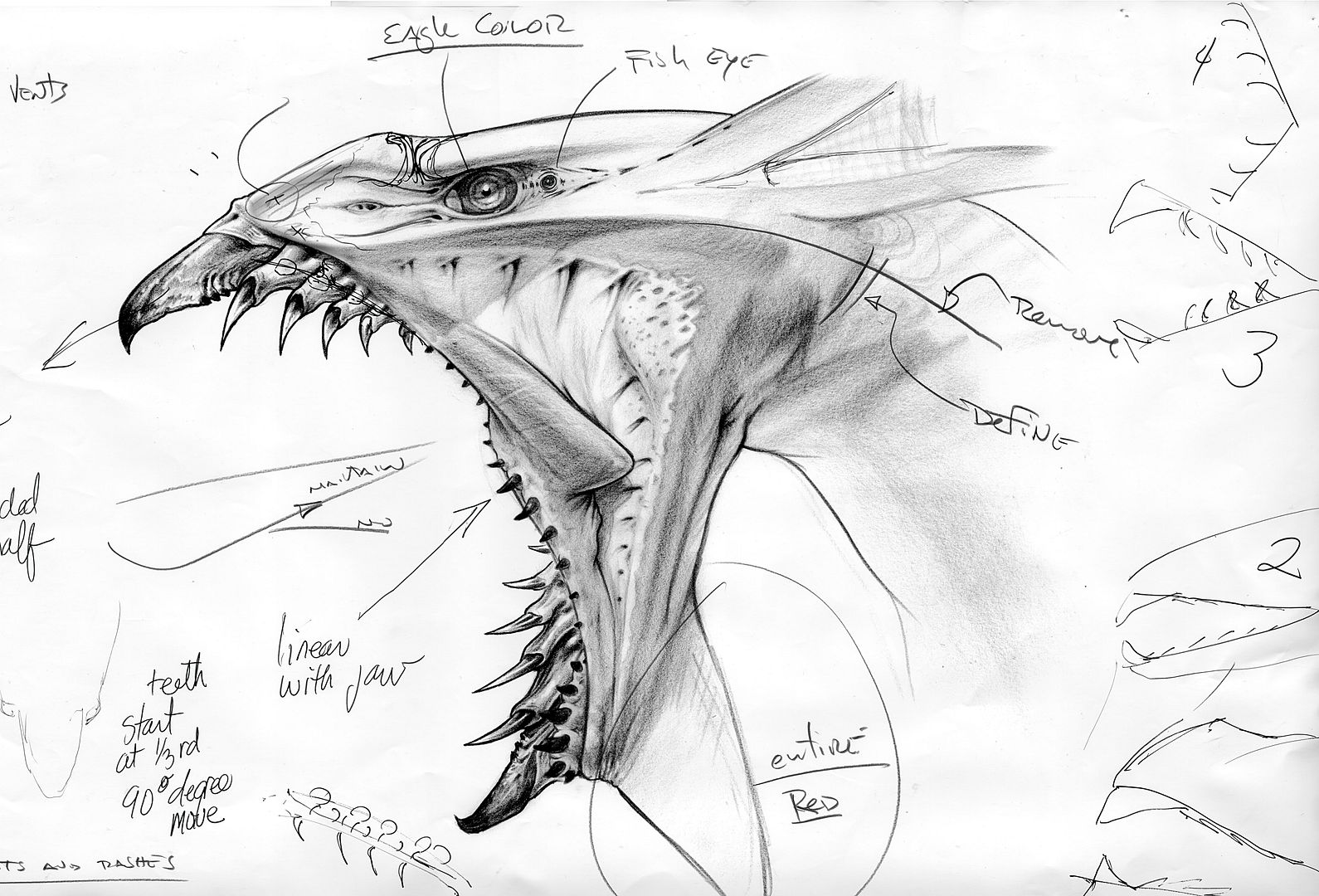

In an exclusive epilogue, James Cameron confesses that he feverishly wrote Avatar in 1995 over the span of just three weeks, fueled largely by his own imagination, every piece of fantasy art ever created, and his rigorous, extensive experience under the ocean. While certain things were specific to Cameron’s preferences—namely the Thanator and Viper wolf drawn by himself—all others were achieved through a sometimes turbulent, always rewarding collaborative process with a talented team of artists, designers, scientists and technologists. “The goal [of the design] became to mix the familiar and the alien in a
unique way,” Cameron states. “To serve the metaphor and create a sense of familiarity for the audience, but to always be alien in the specifics.”
Lucky, lucky audience.
Avatar Trailer:
The Art of Avatar was released November 30, 2009. Avatar wemt into wide release in IMAX and theaters nationwide on December 15, 2009.
~*ScriptPhD*~
*****************
ScriptPhD.com covers science and technology in entertainment, media and advertising. Hire our consulting company for creative content development.
Subscribe to free email notifications of new posts on our home page.
]]>
We are in the midst of a pandemic, folks. A pandemic of fear. A truly formidable novel strain of influenza (H1N1) is spreading worldwide, creating an above-average spike in seasonal illness, the genuine possibility of a global influenza pandemic, and an alarmed public bombarded with opposing facts and mixed messages. It’s understandable that all of this has left people confused, scared and unsure of how to proceed. ScriptPhD.com cuts through the fray to provide a compact, easy-to-understand discussion of the science behind influenza as well as invaluable public health resources for addressing additional questions and concerns. Our discussion includes the role of media and advertising in not only informing the public responsibly, but effecting behavioral change that can save lives. Our full article, under the “continue reading” jump.
The Biology of How Flu Works

Before embarking on a long-winded discussion of flu, the H1N1 strain, vaccines, and media responsibility in the post-internet age, it’s best to start with some rudimentary facts about exactly what the influenza virus is and how it invades and replicates in the human body. While the human genome consists of a whopping 23,000 genes, the influenza virus is relatively simple. Only 8 genes, responsible for creating 11 unique proteins of the influenza genome, can ruin your whole winter. Of those 8, the most important two are the blue H spike (Hemagglutinin or HA) and the green N spike (Neuraminidase or NA). When people refer to strains of flu, such as H1N1, H2N1, H5N1, they are talking about the different genetic “mixes and matches” of the available subtypes of HA, of which there are currently 16, and NA, of which there are 9 to date. Luckily for humans, only small permutations of these end up posing a danger to our healths: the first three hemagglutinins (H1, H2, and H3) and selective neuraminidases (N1 and N2 in pandemics and N3 and N7 in isolated deaths) are found in human influenzas. Predicting future deadly combinations of the HA and NA enzymes with a degree of certainty presents an enormous challenge to biologists.
Think of the H spike and N spike as the Bonnie and Clyde of influenza infection—they have to work together to pull off the heist. The H spike finds special receptors on the surface of cells that contain an organic molecule called sialic acid, which it then sticks to and uses to form a chemical bond between the virus and the cell, like a lock going into a key. But as long as the blue H spikes are clutching to the cell’s surface, the virus is immobile. So the N spike comes along and cleaves the sialic acid chemical bond, the virus is free to make itself at home and you are one sick camper. The two current influenza drugs on the market Relenza and Tamiflu act as inhibitors, or blockers, of the NA enzyme.
In what is the best visual representation I have ever seen of how flu invades and replicates in the body, NPR teamed up with medical animator David Bolinsky to explain how one lone virus copy turns into millions by using your body’s own DNA machinery.
Seasonal Flu vs. Pandemics, A Big Difference

Each year, approximately 250,000 to 500,000 people die worldwide of influenza (36,000 in the United States). This “seasonal flu”, an infection of the respiratory tract, primarily kills high-risk populations—older people, children, pregnant women and immunocompromized patients. Seasonal flu epidemics are caused by the circulation of a group of viruses, primarily Type A, that have already presented in the human population and for which we have developed vaccines and built-up immunity. A flu pandemic requires the introduction of a new type of virus for which we have not developed innate immunity under the following conditions:
•presence of a brand new virus subtype in the human population (usually mutated from an animal form of influenza)
•the virus is capable of causing serious illness in humans (something H5N1 bird flu, for example, is not yet able to do)
•the virus can spread easily from person to person
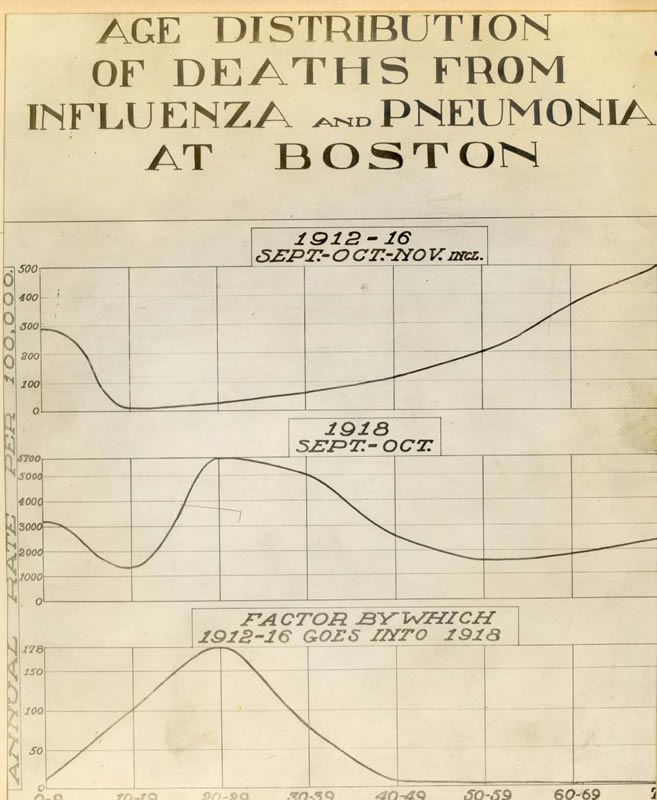
There have been three major post-industrial pandemics: the 1957 Asian flu, the 1968 Hong Kong flu and of course, the 1918 Spanish flu. The 1918 pandemic, one of the worst public health disasters of all time, killed 50 million people worldwide (a conservative estimate) at a time when the global population was only 2 billion—yes, 2.5% of the world’s population. It is said to have killed more people than the Black Plauge and the AIDS epidemic. Besides the three provisions discussed above, there is one major difference between pandemics and yearly epidemics: how they kill. The graph on the right, containing preserved data from 1918 shows two different death curves, one from regular epidemics in and around the Spanish Flu, and another from the Spanish Flu itself. Normally, yearly flu primarily kills the extremely young and extremely old, what epidemiologists call a “U-shaped curve”. Pandemics such as the 1918 flu kill primarily healthy young people, resulting in a “W-shaped curve”. World Bank economist Milan Brahmbhatt estimated that the economic toll of a similar pandemic, due to the loss of such a chunk of the healthy work force, would be approximately 2% of the world’s GDP.
So why all the fuss about H1N1 swine flu, and is it warranted? From a public health epidemiology standpoint… yes. Biological mapping and sequencing has revealed the H1N1 virus to be a novel mutation that has not circulated in human populations before this year. It has also fulfilled all of the requirements to be classified as a pandemic. On June 11th, Dr. Margaret Chan, Director-General of the World Health Organization declared H1N1 at the start of a worldwide flu pandemic. Just a week ago, President Obama declared a state of emergency in the United States to help mitigate the spread of H1N1. To date, it has killed approximately 6,000 people worldwide, with the European Centre for Disease Prevention and Control estimating an 11% increase in deaths just this week. While it is not a preordained certainty that H1N1 will absolutely result in a global pandemic carrying a similar degree of severity to any of the three from the 20th Century, it has enough disconcerting characteristics and pandemic potential to validate scientists’ calls for preventive measures, including vaccination and anti-viral stockpiles. For a terrific rundown and rebuttal of some common swine flu myths, I recommend this New Scientist article.
I also feel the need to address controversy surrounding the H1N1 vaccine, which has been both unduly vilified in the general population and improperly explained by the general media (a subject we’ll delve into in a moment). Fewer than half of Americans say they are planning on getting the H1N1 vaccine for a multitude of reasons, not the least of which include complacency about the virus potency and fear of side effects from the vaccine. While we have strived to address questions about the H1N1 virus above, I cannot state this more strongly or definitively: the vaccine developed for H1N1 is not being manufactured any differently than seasonal vaccines. It has the same ingredients, safety profile, and side effects (rare). The official flu site of the U.S. Government provides an excellent overview of vaccine safety and ingredients as well as a link for common questions and answers.
How Smart Media and Advertising Could Save Lives

The idea of advertising and marketing as tools to combat public health crises is certainly nothing new. As early as the 1860s, and peaking during the two World Wars, clever taglines married beautiful artwork to combat everything from venereal disease to tuberculosis, and they worked. Now a permanent collection of 20th-century health posters at the National Library of Medicine, these compelling, cheeky visual messages changed soldiers’ sexual habits abroad, cultural norms around communicable diseases, and widespread awareness of rising epidemics. Those campaigns were, of course, launched during a less cluttered technological era, but sometimes, simple, smart advertising can be the most effective.
Especially in today’s age of multitudinous multi-functional multimedia, more information can just mean… more information. A recent study from the World Bank addressed why we don’t do much about climate change despite the plethora of data that conclusively deduces we must. The reasoning? An influx of too much information and not enough targeting of individual behaviors. And make no mistake that advertising has an enormous subconscious influence on our behavior. A seminal paper out of the Yale University Psychology Department earlier this year showed external cues from television advertising increased food consumption 45% in children and adults irrespective of hunger. There is no reason that such enormous influence can’t and shouldn’t be harnessed in eliciting positive behavioral changes during the 2009-2010 flu season (and beyond).

The media in particular, with their highly sensationalized mood swing swine flu coverage, has played an enormously irresponsible role in fanning the fires of public fear and misinformation. Remember the desolate empty streets of Mexico City? Or the U.S. pre-emptively declaring a public health emergency? Quarantines, social distancing, vaccine and Tamiflu stockpiles, dire expert warnings, surely, impending doom was imminent. And when it wasn’t, the Great Swine Flu Scare of spring turned into a Great Swine Flu Joke of the summer— literally. Social media satire included Facebook and Twitter pages seemingly run by the swine flu itself and a hilarious interview with the Los Angeles Times. The humor underscored a more serious swine flu fatigue incurred by intense media saturation, often missing key scientific information or balanced reporting. In its analysis of swine flu accuracy in the media, the Columbia Journalism Review recently lambasted the ubiquitous hype, and the cognitive dissonance between fact and fiction in reporting by “respected” journalism outlets.
Worse than these confusing messages is the tapestry of opinions masquerading as fact about a subject buoyed by plenty of sound science and research. The most egregious offender of late was Bill Maher, who used his show as a bully pulpit to decry immunization with the H1N1 vaccine, and the severity of H1N1 itself, in an interview so fraught with misguided medicine and unsound reasoning (the majority of which we’ve addressed above) that it pains me to give it publicity on my site. The video is worth a view if only for the rebuttals of a more rational Bill, former Senate majority leader Dr. Frist.
The use of advertising as a viral public health campaign is a double edged sword. Back in 1976, an earlier wave of swine flu fear gripped the nation. Like the 2009 strain, it was unseen in the general population since the 1918 flu, and touched off a similar wave of national panic about whether a widespread plague threatened the entire United States. In what has argued as both public health’s finest hour and the swine flu “fiasco”, President Gerald Ford decided all 220 million Americans had to be immunized, and ordered hasty production of an untested vaccine that killed over 500 Americans and was ultimately halted as unsafe. Part of the government propaganda to encourage vaccination included the two frightening television commercials below.
As detailed in Arthur M. Silverstein’s book “Pure Politics and Impure Science” (a good summary can be found here), the aftermath and deleterious impact on trust in the public health infrastructure was multi-generational and devastating, perhaps even emanating in the skepticism towards the 2009 vaccine, despite entirely different safety guidelines and circumstances. A smarter approach to engaging the public is a current BBC television spot done in concert with the British Government:
This is such an excellent piece on multiple fronts. The tagline—catch it, bin it, kill it—effectively communicates sound hygiene and advocates hand washing, still by far the most potent way to ward off germs and prevent illness. It’s sleek, clever, funny, and most importantly, gross! I washed my hands after just viewing it. In conjunction with print ads, billboards and yes, old-fashioned posters, similar public service announcements should be placed during the most popular primetime television shows, sporting events, concerts, other public gatherings, and most importantly, as part of any in-flight boarding process.
What’s a Confused Germaphobe To Do?
Despite the circulation of conflicting information and influx of divergent opinions, there are some genuinely useful resources and recommendations for this flu season. Here’s a good start:
Get a flu shot! Immunization against influenza, both the seasonal and H1N1 strains, remains the only surefire effective defense against the viruses. One of the most solid and eloquent arguments for the flu shot that I’ve seen comes from Dr. William Marshall, an infectious diseases specialists at the Mayo Clinic:
Wash your hands! Short of getting vaccinated, there is no easier, cheaper, faster, more effective way of preventing colds and flu. In fact, the CDC estimates that 80% of all seasonal flu is spread by hand contact. However, not only do you need to wash your hands, you need to do so properly.
Eat, drink, sleep Never underestimate the role that good nutrition, plenty of water, and a good night’s rest can have to boost the immune system and help it naturally combat exposure to viruses, especially if you make the choice to abstain from the flu vaccine. Of all three, sleep is the most critical. Read this fascinating NY Science Times article from earlier this fall about a sleep study that showed a direct correlation between lack of sleep and increased likelihood of catching a cold.
Accept no imitations Yes, Virginia, people try to take advantage and scam even in a pandemic. Color yourself shocked. The government is issuing warnings about a growing list of Swine Flu scams, some of which could be deadly. Remember, only Tamiflu and Relenza are recommended as flu treatments and only your doctor can prescribe them. The FDA has also issued a comprehensive list of fraudulent H1N1 products, including air purifiers, soaps, masks and other concoctions. Before buying ANYTHING that claims to prevent or combat the flu, please refer to it.
Get technical Thanks to the wonders of modern technology, it’s easier than ever to track the flu, know how to prevent it and what to do if you get it. Flu.gov, the WebMD Focus on the Flu site, and the Centers for Disease Control flu homepage are excellent educational starting points. Google now provides a flu tracker to explore the severity of flu trends around the world. And for those of you that are, like the ScriptPhD, of the iPhone persuasion, a new iPhone application called “Outbreaks Near Me” developed at MIT, and available as a free download, provides GPS data on outbreak clusters in your neighborhood.
If you have any other tips, cool gadgetry, public health resources or web sites we should add to our list, please don’t hesitate to comment or email me.
~*ScriptPhD*~
*****************
ScriptPhD.com covers science and technology in entertainment, media and pop culture. Follow us on Twitter and our Facebook fan page. Subscribe to email alerts for new posts on our home page.
It’s not often that world-renowned scientists crash in the heart of Hollywood to talk about Nobel Prize-winning physics research. But on a recent summer night, the ScriptPhD, along with a handful of lucky astronomy aficionados, was treated to a light show with a side of general relativity. At LA’s famed Laserium CyberTheatre, Yale physicist Charles Baltay, also known as the man responsible for Pluto’s demise, captivated a delighted audience with about 10 billion years of physics, starting from the Big Bang to Pluto’s demise. Continuing the physics theme was a visually stunning array of laser pyrotechnics set to the thematically appropriate tune of Pink Floyd’s “Dark Side of the Moon.” For Dr. Baltay’s lecture, entitled “Exploring the Dark Side of the Universe”, and the psychedelic imagery of the world’s most advanced laser light show, please “continue reading” under the jump.
Ivan Dryer, Pioneer of the Modern Laser Light Show

The evening’s festivities were graciously hosted and introduced by Ivan Dryer, founder of the Laserium and a Los Angeles legend in the world of entertainment technology. Mr. Dryer is generally considered to be the father of commercial laser light shows. Starting out as a filmmaker in the 1970s, Dryer transitioned movie lasers used primarily for film effects into a show at the Los Angeles Griffith Observatory under the name “Laserium”. Laserium shows went on to be played in 46 cities worldwide, and were viewed by over 20 million people, eventually gaining recognition as the longest running theatrical attraction in the history of Los Angeles. “I had no idea how popular this would be,” Dryer said. “It was supposed to be temporary and wound up as a career. As many as 20 million people have leaned back and watched the sky light up to music.” What made that experience so popular? Dryer thinks it’s something about the fundamental appeal of light: “The quality of that light triggers something in the brain, I think. It gets into the limbic system” — the central neurological structure where the passions reside — “and stirs things up. The light and the music trigger our deepest emotions.” The light and the music continue at the Laserium’s permanent new cybertheater in Hollywood. Anyone who goes from being an aspiring young astronomer to an aspiring young filmmaker gets the ScriptPhD.com seal of approval!

And speaking of astronomers, the audience was treated to a lecture by world-renowned cosmologist (and the man responsible for the astronomical demotion of Pluto), Dr. Charles Baltay. Dr. Baltay, a Higgins Professor of physics and astronomy at Yale University, was born in Hungary and raised in Bavaria shortly after World War II. After relocating to the States, Dr. Baltay received a physics PhD from Yale and taught at Columbia University. What follows is a rare lecture that makes esoteric physics and astronomy approachable and enjoyable to non-scientists and scientists alike, while deftly explaining the sophisticated cutting-edge frontier of the expanding cosmos.
Lecture: Exploring the Dark Side of the Universe with Dr. Charles Baltay
I’ll be talking about the dark side of the universe, but by this I don’t mean Washington politics or the CIA. I’ll be talking about something called cosmology.
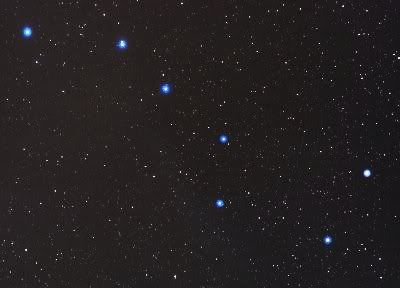
So this is our view of the large-scale structure and evolution of the universe. The first question is the structure. At small scales, the Earth is going around the Sun, the Moon around the Earth, there’s a lot of lumpiness, but when we look at the large scale, it’s very smooth and uniform. The next question is evolution—again, lots of irregular motion at small scales, and at the large scales, it’s pretty much the same as it’s been. Many of you might recognize this picture as The Big Dipper. It’s looked the same to the Greeks, to the Arabs, since recorded history, so our view was that the Universe was really not changing. It’s forever.
The questions we ask in cosmology are: is the Universe really static or is it evolving in some way? What is the age of the Universe? Is it infinite? Is there even a meaning to the age (if it’s forever then there’s no age)? What is the future development of the universe? What is the “stuff” that the Universe is made of?
Let me start by giving you the present view of the Universe. We believe that the Universe is not static but in a state of uniform expansion as an aftermath of the big explosion. This we call the Big Bang model.
We believe that we cannot see most of the “stuff” in the Universe. The picture above of the stars and galaxies is what we call “visible matter”. It turns out that visible matter comprises 1% of the stuff out there. Most of it is dark matter and dark energy, stuff we cannot see and that we don’t know very much about. And we believe that on the largest scales, the universe is very smooth and uniform. We believe that there is such a thing as an age, the time since the Big Bang. And we believe that to be 10-20 billion years. Some people say 13.2 billion [as in photo above], which may or may not be right, but that is a theory.
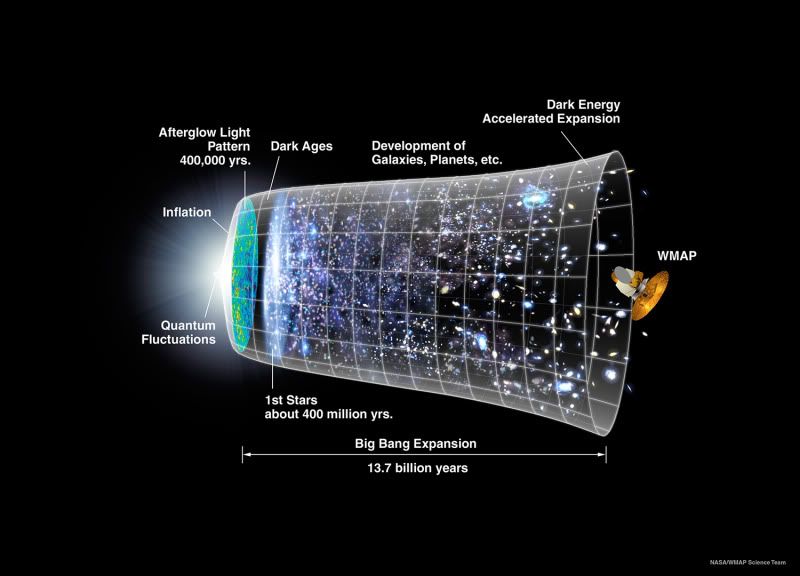
We don’t know the future of the Universe. It may keep expanding forever, like a big chill, or it may recollapse. Which will happen will depend on the amount and nature of this dark matter and dark energy. Right now we really cannot predict the future until we learn more about these properties. So this is a quick summary and you can now go to sleep for the rest of the lecture. [ScriptPhD note: we highly discourage this. It gets even better!]
To fill in a few details: how do we know all of this stuff? It doesn’t come from religious books, it’s not voodoo science. It started with a guy called Edwin Hubble who invented Hubble’s law. What he noticed is that distant stars and galaxies are moving away from us. The further something is, the faster it’s pushing away. That’s Hubble’s Law in a nutshell: the recession velocity is some constant times the distance. The point here is that the further away things are, the faster they’re rushing away from us.
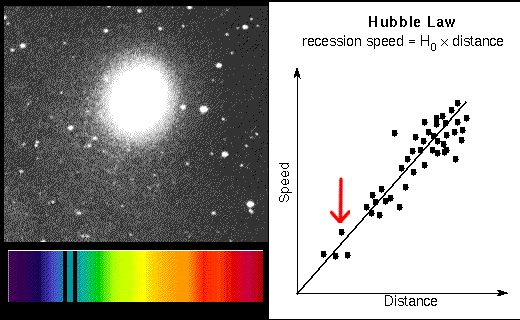
Now how does he know this? And the key idea here is something called the Doppler Effect. Light is a wave is a wavelength. And the wavelength determines the color. So blue is about 4,000 Angstroms, green is 5,000 and red is about 7,000 [see animated chart above.] The numbers here don’t matter. The longer the wavelengths look like red to your eye, the shorter wavelengths look bluish. We’ve all experienced the Doppler Effect. You’re on one of your beautiful freeways, if a car coming the other way blows their horn, you hear a high pitch and then as they pass it falls to a lower pitch, have you noticed this? [Note: to hear the Doppler Effect, click on the link below.]
The higher pitch is the shorter wavelength, then they pass you and they’re moving away from you, you get a lower pitch or a longer wavelength. So if the source is approaching the observer, you get shorter wavelengths, meaning towards the blue, so it’s called the Blue Shift. If something is moving away from you, then the pitch drops, you get longer wavelengths, which are redder, so it’s called the Red Shift. This is the whole clue to this [universe moving away faster] business. Measuring the red shift tells you the velocity that’s moving away from you. But how do you measure the red shift?
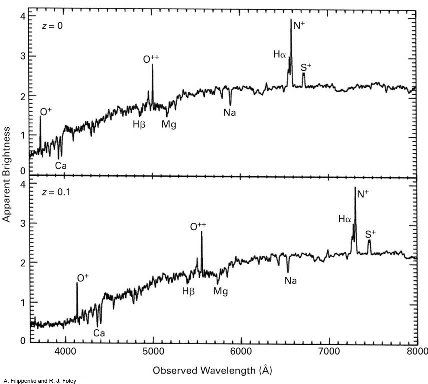
This picture is called a wavelength spectrum. This is a numerical representation of the wavelength of light coming from a distant star. And you notice certain items give you certain colors, like neon is a bluish color, and sodium lights a yellowish. Each of those colors show up as a line [represented by a specific wavelength]. It doesn’t take a rocket scientist to see that this top pattern is the same as that bottom pattern, but it’s displaced in wavelength [because it’s coming from a more distant star]. That’s how we measure the red shift. However much the wavelength is displaced, this tells you the red shift, which tells you the velocity. So what you do is look at a lot of distant stars in the galaxy, which is what Hubble did, measure their red shift from pictures like this, and figure out that the further away something is, the more rapidly it’s moving away.
Why does that mean an expanding universe? Suppose you go to a marathon in your city of choice and as usual you are late to things. So you arrive late and by the time you get there, you see that Sue the leader is 16 miles from the starting line. And she is running at 8 miles per hour. Joe is running at 4 miles per hour, so he only got 8 miles from the starting line. And some loser is only doing 2 miles per hour, so he only got 4 miles away. So if you all start at the same point, the faster you run, the further you get away. And that’s exactly Hubble’s Law [as relates to Universe expansion.] To put it another way: the further something is, the faster it’s running away from us. So that’s all there is to it. Very simple.
Suppose I come late to the marathon and I say to someone, “How long has this race been going on?” [the equivalent being, how old is the universe?] It doesn’t take an astronomer to say, 2 hours. If Sue is running at 8 miles per hour, she’s 16 miles from the beginning, the race has been going on 2 hours. So that’s the age of the Universe. All you have to do is measure how fast the galaxy is running away from us and how far the distance is, and you get the time. So the age of the Universe is the distance to some star divided by its velocity. But we make one big assumption here. That they’re running at a constant velocity. Suppose that Sue was really running faster, but is now getting tired.

So that brings up the next big question: is the expansion velocity of the Universe a constant or not? And you say that the answer is simple, because there is stuff in the Universe, like magnets, people, worms, stuff, gravity is attracted, so if the thing is expanding, gravitational attraction has slowed down the expansion. So we would expect the expansion of the Universe to slow down, to decelerate. And the rate of the deceleration tells you how much stuff there is. The more stuff, the more gravity, the more it slows down. But how do we measure these things? How can you measure what the velocity was in the past, say a billion years ago? If we are looking from Earth at a supernova (that’s an exploding star in the Universe), and let’s say that it was 1022 kilometers away. It takes light 3 billion years to get from the supernova to the Earth. So the light that we see today was really emitted 3 billion years ago. And the properties of that light tell us about the Universe as it was 3 billion years ago, and in particular, the red shift of that light tells you about the extension velocity of the light in the past. By looking at supernovas at different distances, you are indirectly measuring the expansion velocity of the Universe. Distance translates to time in the past, because light travels with finite velocity.
Scientists did this experiment and there was a huge surprise: the expansion velocity was smaller in the past and is bigger now. The Universe is accelerating! It has no business doing that. It cannot possibly do that [based on all the points discussed above]. All the laws of physics, and everything we know say that this cannot be. So this study came from guys at Harvard, so we didn’t believe them, but then people from Berkeley replicated the experiment and we now have to believe it. This is a strange state of affairs. All of the stuff in the Universe attracts gravity, and cannot cause it to accelerate. Scientists are not very smart and savvy, but we’re smart enough not to call the New York Times and say, “We just spent umpteen million dollars and we don’t know what the hell is going on.” So instead, we call the New York Times and say, “We discovered dark energy. What’s dark energy? We have no idea.” But dark energy is something that has to be pausing gravity. So we hypothesized dark energy is pushing the Universe apart and it’s qualitatively different from anything we think about, and it’s dark because we don’t see it. This is kind of where we are currently in this research field.
So we all recognize Albert Einstein, who came up with the Theory of General Relativity. And when you do the calculations and you put everything together, you come to this very startling conclusion: that the visible stuff in the Universe is 1%, and dark matter and dark energy are 99%. So all our physics books, the books in the Library of Congress are, but alas, 1% of the Universe. The rest [of the matter], we know almost nothing about. So the question is, how do we learn more about the age, the history and the future of the Universe? One thing we would like to do is look further back in cosmic time. The experiments we’ve done up until now have only gone back a short time, maybe 1 or 2 billion years. We would like to go back maybe 10 billion years to trace out this expansion velocity. Going back to our earlier example, I see Sue running the Boston Marathon, and I’d like to trace out her velocity from the beginning of the race. If I know that, I can reconstruct the exact age and predict the future. So going back further in time, long ago, means further away, because that is the direction the light is coming. Far away means these supernovas are very faint, so you have to go to space to look for them.
We have proposed a space mission [the SuperNova Acceleration Probe as part of the Joint Dark Energy Mission] to look for these supernovas to take us back further in time. On the other hand, you also need a sample of nearby supernovas to compare [them], and that we have to do from the ground, because they’re relatively bright since they’re close-by, but they are very rare. The ground experiments will give us the baseline supernovas and that is the Palomar Quest Survey which is underway at the Palomar Observatory not far from Los Angeles as a collaboration between our group at Yale and a group at the California Institute of Technology. The SNAP space mission [link above] is a proposal with about ten universities collaborating, and we’ll eventually have to launch one of these Delta-4 rockets in the future [view conceptualized animations of the project and space projections here].
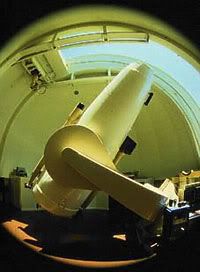

Here is a picture of the Schmidt Telescope that we are using at Palomar and a sample of some of the types of pictures that we are getting, such as the Andromeda Galaxy. But how do we find these supernova explosions? These are exploding stars, they take about two weeks to get to their peak brightness, and they take about six weeks to fade away. So we take one picture and compare it to a picture taken a month before, and then subtract the images to determine the supernova strength [see graphic in supernova picture above]. We have one big nuisance. And that is that in some of the images, you see an object moving over, and circling between the stars. That’s not a supernova explosion, it’s something that’s moving down the solar system. So within the background of the supernova search, are there other planets within our own solar system?

Back in the 1930’s, before computers, this guy named Dr. Clyde Tombaugh looked for 30 years by eye on photographs to find Pluto. And we’ve now started finding more planets, at least six to date, some that are bigger than Pluto:

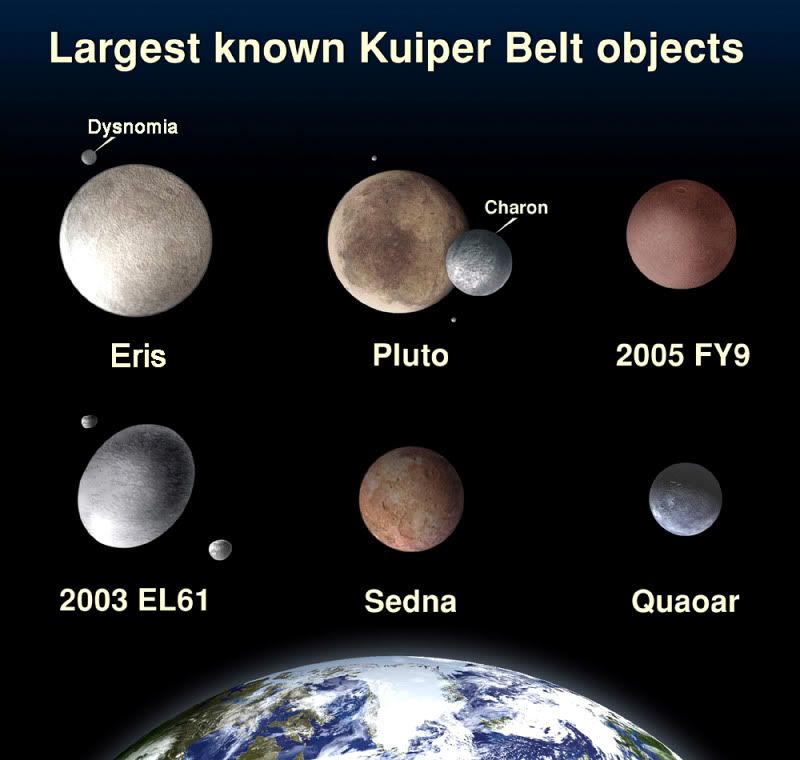
Because of these discoveries, we now believe that the solar system is probably twice as big as we used to think. So this upset people quite a lot and they said, “Either we call these guys planets, or we demote Pluto.” So that’s what happened. We have blood on our hands. Actually, what really happened is that everybody gets to be called a planet, with five inner planets, two giant planets, and four outer planets. And maybe we will find a few more [during the course of the Palomar survey]!
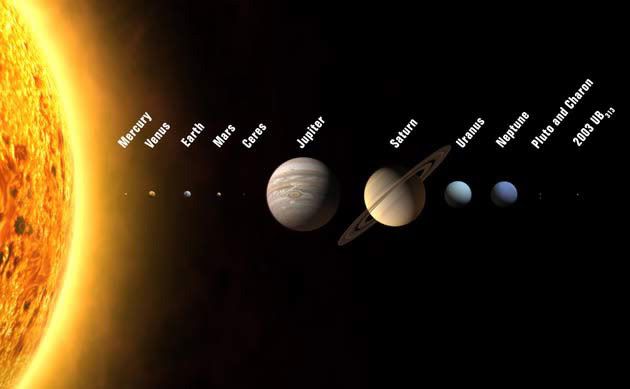
Question and Answer with Dr. Charles Baltay:
How often do you get lucky enough to witness a world-famous physicist answering questions and explaining high-order physics in every day layman’s terms? Not often. Following is the transcript of Dr. Baltay’s post-lecture question and answer session, during which his natural wit often shined through.
How is your work going to address dark energy and dark matter?
Charles Baltay: The approach we have now is to trace out the history of the expansion. And from that we can deduce how much dark energy there is. Of course, a more complete answer would be: take Einstein’s formulas of general relativity and… it gets complicated. But the basic idea is that the expansion history will tell you about the dark energy.
What got Pluto “declassified” when there are other planets that are much smaller?
CB: Well, declassified may not be the right word. It was reclassified as a minor planet, to make the distinction between the giant planets and the minor planets. So it’s an International Astronomical Union, and they spend their days arguing and this is what they came up with.
How do you determine the distance of the planets and supernovas you study?
CB: With great difficulty. Measuring distance is a big problem; that’s a hard thing to do. The reason I keep emphasizing supernovas—there are certain classes of supernovas that we know how bright they are intrinsically. So from the apparent brightness [of those standards] we can judge the brightness. It’s like a car headlight, if you knew how bright it was up close, then you see it from a distance, you could say the light passed off is 1/r2, from the intensity deduce the brightness [and ergo the distance]. And that’s why we pick out supernovas of all the possible things we could look at.
[ScriptPhD note: You must imagine the sassy molassy British girl asking this question—it’s so much more fun!] We know that there’s these lumps of rocks circling the sun. Why does it matter what we call them and is it really a good use of grown men’s time to argue about it?
CB: Well the International Astronomical Union has to have something to argue about. It’s a disappointing thing to argue about. You’re right—there are planets, there are asteroids, there are comets. So they are all things that go around the sun. So people like to classify. Biologists say that there are plants with three leaves on the end, versus five leaves on the end, and they give them names. So that’s what people do.
Sassy Molassy: It’s kind of an old-fashioned way to go about science, isn’t it?
CB: Well, yes. I don’t particularly find it exciting, but that’s my sole resistance to energy balance, whether we have 9 or 10 planets. Who cares?
Are you familiar with Stephen Hawking’s theory that there are singularities that are infinitely large and infinitely small? [Read about the Penrose-Hawking Singularity Theorems here.] And if so, do you believe that that might be an explanation for why there is spin and not just Big Bang thrust?
CB: Well, from what I understand about those theories, none of them encompass repulsive gravity. So dark energy is really different from anything that anyone’s talked about, in that it has repulsive gravity, and that’s what pushes the universe apart. So none of those weird things that people talk about—worm holes and singularities—none of those explain dark energy. We’re looking at something really quite new.
How does dark energy compare with the other forces, like gravity or electromagnetism?
CB: If I knew I’d publish immediately! We just don’t know.
Is there some correlation between the dark energy that you’re talking about and Einstein’s Cosmological Constant which predicts an expansion of the universe based on its properties of space?
CB: Yes. You’ve been reading books, obviously. OK, so let me mention a bit of history. Einstein wrote down his equation [E = mc2] in 1916, without a cosmological constant. He realized that that’s inconsistent with a static universe. In a sense, I can’t take this jacket hanging on this chair and leave it in the air. Gravity will make it fall down. So Einstein, revolutionary as his thinking was, firmly believed that the universe is static. This was before Hubble’s constant. So he said, “How can I fix up my equation?”, he put in this extra term, he called it his cosmological constant, which canceled out the gravitational attraction, and to him it was just an extra term. Then in 1930 Hubble said, “The universe is not static,” and Einstein said, “Oh, the cosmological constant is the biggest blunder of my career.” Now, I don’t know what he meant by that, because it couldn’t be one thing. Maybe what he meant was, “Had I stuck to my guns, and said the Universe cannot be static, I could have become famous!” [laughter] So from 1930 until just a few years ago, everyone used the cosmological constant. It was something that Einstein used to catch up his theory to be consistent with the semi-state universe. But we discovered that the universe is accelerating, maybe the cosmological constant is doing it. So that’s one candidate for dark energy.
Since waves tend to travel through mediums, is dark matter the medium by which light travels through?
CB: No. But how do I know that? I don’t think it is. We don’t know what dark matter and dark energy are. So it’s just the beginning of the story.
Are the experiments you talked about the only experiments happening on dark matter and dark energy?
CB: No. There are at least three or four more experiments being planned by various other techniques. It’s sort of a hot topic. It’s now the holy grail of cosmology. So a lot of people are doing it with different things. Of course we have the best design, but…
Can dark matter exist in a black hole, do you think?
CB: I don’t know. As I said, if I knew I’d publish.
Is there a number associated with Hubble’s Constant, just like pi?
CB: There is a number. It is hotly debated but the general values are described here. It’s not a number like pi, that’s a geometrical number. It’s a number that we have to measure.
What can your space telescope see that the Hubble cannot?
CB: The answer is the following. It’s called field of view. When you pick up a pair of binoculars, sometimes it has a very narrow field of view. And sometimes a big field of view. If you’re trying to find many, many supernovas, you want a wide field of view. The Hubble has a very narrow field of view. So we have to do something better than the Hubble. I’m being very modest today.
Now that we’ve discovered another [planet in the] Zodiac, how does that work with the horoscope? If you were a Leo, are you now a Virgo? [laughter]
CB: That’s beyond my pay scale.
Lights and Lasers and Pink Floyd, Oh My!
The highlight ending of this otherworldly evening was an hour-long bravura of luminescence to the soundtrack of “Dark Side of the Moon” by Pink Floyd. For those that have never experienced a show at this magnificent hidden Hollywood gem, it is, according to People Magazine, “the closest thing to tripping out in inner space.” Check out just a slice of the experience in pictures:







Our complete photographic collection from the show can be found as an extra feature on our Facebook fan page. Please credit all photography to ScriptPhD.com.
It would probably take extraordinary measures to travel far enough to see a distant supernova or nascent planetary body, but if you should find yourself in Los Angeles (or have been living here all your life) and want an exciting, explosive audiovisual scientific excursion, go to the Laserium’s permanent home in the heart of the Hollywood Walk of Fame. Great science amidst the global capital of entertainment… it doesn’t get better than that!
~*ScriptPhD*~
*****************
ScriptPhD.com covers science and technology in entertainment, media and advertising. Hire our consulting company for creative content development.
Subscribe to free email notifications of new posts on our home page.
]]>
